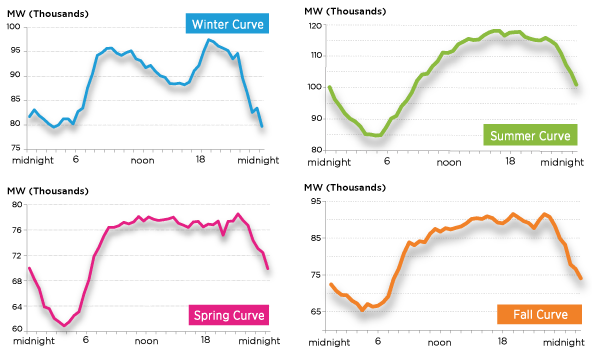The Environmental Protection Agency estimates that, on average, 30% of energy used in existing and new commercial buildings is wasted, proving there are vast opportunities to conserve and manage energy. Pinpointing the source of wasted energy isn’t always easy, and it helps to understand how external factors related to the weather affect your energy consumption curve.
Seasonal weather trends can have a noticeable impact on energy consumption as heating and cooling needs fluctuate. Here are a few reasons to collect data on seasonal shifts in building energy:
- Temperature affects 44–67% of the electricity demand variability at seasonal time scales
- Electricity consumption in summer months has doubled over the past fifty years in American homes due to climate change, according to the Environmental Protection Agency
Given the importance of temperature as an indicator of energy consumption, it is helpful to track and monitor seasonal shifts across building portfolios. It is important to keep track of your building data to analyze, forecast, and predict your building portfolio’s energy requirement trends.
Seasonal energy consumption variables
Energy consumption tends to be highest in winter and summer for most businesses when they require greater heating and cooling resources in buildings. Daily temperature change and activity patterns also fluctuate differently depending on the season. PJM, for example, the regional grid operator for 13 states and the District of Columbia, shares a comparison of daily energy consumption curve averages for different seasons in its region.

PJM’s measurements show noticeable differences between winter and summer seasonal daily energy curves. Summer energy consumption increases to power cooling as the sun rises and sets. In winter, mornings and evenings are the peak hours, while fall and spring share similar curves.
Grid operators responsible for balancing the energy load on the grid analyze this data to help them plan their use of both variable renewable energy resources and other non-renewable resources to avoid excessive energy use peaks or power shutoffs. With more renewables in use, the grid balancing act becomes more challenging, and some utilities have begun to explore variable pricing models to disincentivize their clients from running equipment and appliances during peak-use hours. In these areas, businesses can benefit from lower energy prices by shifting their hours of peak demand.
This kind of data is available in an aggregated form across a region to include residences and commercial buildings, but businesses may benefit from accessing fine-tuned data specific to their own operations. Seasonal energy consumption data shows patterns that not only help plan and time HVAC heating and cooling activities but can also help businesses better align with their energy consumption and decarbonization goals.
Climate change and energy consumption
Seasonality is already complex under stable, predictable conditions, but climate change is making seasons less predictable and the rate and intensity of seasonal changes shows variation for different warming scenarios and regions.
Long-term averages show summers becoming hotter, along with increasing precipitation and humidity. These trends lead to an increasing demand for summer cooling in buildings to maintain comfortable working temperatures. In addition, weather extremes create less predictable patterns, causing grid imbalances and more frequent power shutoffs.
For long-term energy resource planning, businesses may want to forecast the long-term impacts on their energy consumption across different scenarios. The information can help businesses prepare for energy resource management that promotes business continuity and allocates capital expenditures toward smart HVAC systems configurations.
Building decarbonization and energy consumption
Heating and cooling equipment in buildings accounts for approximately 15% of global carbon emissions. More and more businesses are addressing their building-related carbon emissions as part of their long-term sustainability strategies. The relationship between energy source mix and consumption patterns is worth tracking and monitoring as part of a building decarbonization strategy.
Switching to renewable energy resources is important for lowering CO2 emissions, but without energy-efficient HVAC equipment upgrades, energy consumption costs can quickly add up. New research shows how the transition to renewable energy could change the peak seasonal energy consumption period from summer to winter.
This is because electric equipment requires more energy to operate in cold temperatures and renewable resources are more scarce in winter. A switch from natural gas heating to renewables, with no change in energy efficiency or additional long-term battery storage, would create a “falcon curve” for energy with extremely high energy demand in winter months.
This curve can be significantly flattened by adopting air-source, ground-source, or networked heat pumps, which are highly energy efficient, along with long-term battery energy storage for preserving the energy generated by renewables:
- 100% renewable energy requirements with no change to HVAC energy efficiency:
- 28x more wind power generation in winter
- 303x more solar generation in winter
- 100% renewable energy requirements with change to energy-efficient heat pumps:
- 4.5x more wind power generation in winter
- 28x more solar power generation in winter
The research highlights the importance of aligning building decarbonization strategies on both the “supply side” (renewable energy resources and battery storage) and the “demand side” (energy-efficient equipment, operations, and building retrofits) are essential to widespread building decarbonization. These strategies complement each other for energy management according to seasonal weather shifts. Proper building insulation and routine HVAC equipment maintenance also becomes even more critical with the transition to renewable energy resources.

Tracking weather data alongside energy data
Analyzing building performance data can help businesses understand the relationships between a sustainability strategy and seasonal energy consumption shifts. This allows them to make better-informed decisions about cost savings, energy consumption reductions, decarbonization, and business continuity.
There’s no need to rely on average regional data when you can easily track and monitor energy curves directly from your building portfolio. Here are some of the benefits of having this data:
- Analyze changes based on different seasonal variables:
- Seasonal and daily energy consumption curves
- Seasonal and daily temperature changes
- Year-on-year data for historical analysis and trend forecasting
- Expand the range of tracked variables:
- HVAC equipment systems, upgrades and energy efficiency measures and related changes to energy requirements
- Battery storage and renewable energy generation configurations
- Indoor and outdoor air quality
- Indoor and outdoor temperature comparisons
- Space usage and occupancy throughout the day/season
- Routine maintenance activities and scheduling
- Optimize energy consumption and share the data with stakeholders
- Track and measure the effectiveness of strategies
- Forecast the improvements of new approaches
- Demonstrate economic impact
- Demonstrate environmental impact
With our focus on real-time data, continuous monitoring, and analysis systems, Atrius Sustainability helps keep buildings safer, greener, and more sustainable.



